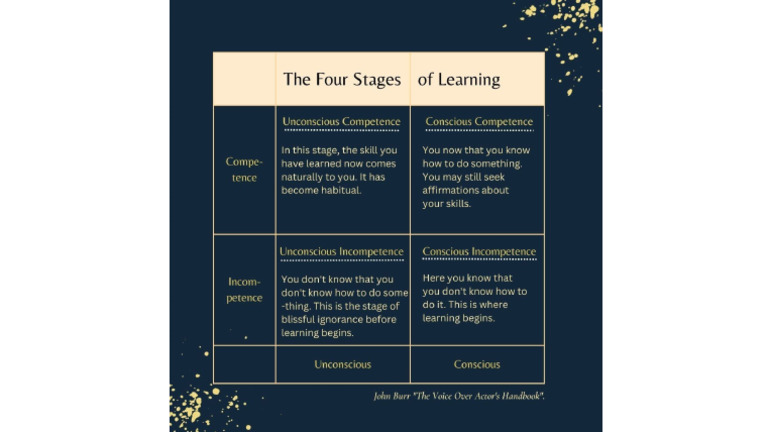In the vast expanse of human experience, the pursuit of knowledge through the mastery of skills has always held a particular allure. The Baha’i teachings encapsulate a profound understanding of how we can approach this journey of learning through four distinct stages. Each stage not only serves as a progression but also poses new challenges and opportunities for growth. What if your most treasured skill could unlock deeper layers of understanding? This playful inquiry invites us into an exploration of the Four Stages of Learning a Craft as illuminated by Baha’i principles.
The First Stage: Unconscious Incompetence
The journey typically begins in the realm of unconscious incompetence. At this juncture, the aspiring craftsman possesses little awareness of the skills needed for proficiency. They may find themselves attracted to the art without any realization of the multifaceted competencies required to master it. This stage can be likened to an uncharted territory, where potential is limitless yet untapped.
In the Baha’i context, this phase is crucial as it illustrates humility. It serves as a reminder that to cultivate knowledge, one must first acknowledge their limitations. Within this framework, one can reflect on the principle of self-examination, recognizing the importance of identifying gaps in their understanding. This serves as a fertile ground for motivation. Without this self-awareness, how can one truly aspire to transcend their current situation?
The Second Stage: Conscious Incompetence
Once the initial phase has been surpassed, learners typically progress to conscious incompetence. It is here that novices become acutely aware of their deficiencies. This is often a pivotal moment in the learning process, revealing the breadth of knowledge that lies beyond their current grasp. The realization can induce feelings of frustration, yet it is simultaneously pregnant with potential.
In Baha’i teachings, this stage reinforces the principle of perseverance. The conscious recognition of incompetence casts a spotlight on areas for improvement. Rather than despairing over shortcomings, individuals are urged to cultivate a growth mindset. Here, the challenge materializes: How can one convert feelings of inadequacy into a driving force for inquiry and exploration? This stage embodies the essence of learning—eagerly embracing the path forward despite the discomfort that may accompany it.
The Third Stage: Conscious Competence
As learners evolve, they encounter conscious competence. This stage is marked by the acquired ability to perform skills with effort and deliberation. Here, practitioners can engage in crafting their skill, though it still demands focused attention. It is a moment of accomplishment; however, it also requires ongoing commitment to refine the skill further.
Through the lens of Baha’i doctrine, conscious competence exemplifies the harmony between action and reflection. It calls for individuals to take deliberate steps toward mastery, an act resembling the pursuit of spiritual virtues. The stepping stones toward conscientious skill acquisition are manifold, yet they often coincide with the pursuit of excellence. The challenge lies in maintaining motivation and discipline. What strategies can be employed to overcome the fatigue that may accompany hours of practice? This inquiry paves the way for innovative approaches and sustained enthusiasm for the craft.
The Fourth Stage: Unconscious Competence
Achieving unconscious competence represents the culmination of the learning journey. At this esteemed stage, skill becomes second nature. Tasks are executed instinctively, with minimal conscious effort. This transcendence marks a transformative experience where learners not only attain proficiency but also engage in creative expression.
Baha’i principles remind us of the interconnectedness between the individual and the community. Unconscious competence is not merely an end unto itself; it radiates outward, influencing others. It encapsulates the ideal of service to humanity, wherein skilled practitioners can share their mastery with aspiration. The challenge here lies in balancing humility with the recognition of one’s influence. How can one use their skills to uplift others and contribute to the betterment of society? Thus, learners become not just artisans but also stewards of knowledge.
Conclusion: A Holistic Perspective on Mastery
The Baha’i vision of the Four Stages of Learning a Craft provides a comprehensive framework for understanding human potential. From unconscious incompetence to unconscious competence, this journey unfolds in layers, each stage intermingling with the others while imparting wisdom and resilience. The path not only emphasizes individual growth but also the collective elevation of society as a whole.
As one traverses these stages, they must engage deeply with each step. Reflecting upon one’s limitations fosters growth, while recognizing competence encourages sharing and learning within community contexts. Ultimately, the mastery of any craft is neither a solitary endeavor nor a fixed achievement but a dynamic interplay of knowledge, creativity, and communal responsibility. As learners ponder the stages of their journey, they may find that curiosity and the collective experience form the bedrock of learning, enriching not just their craft but also their connections to the world around them.
